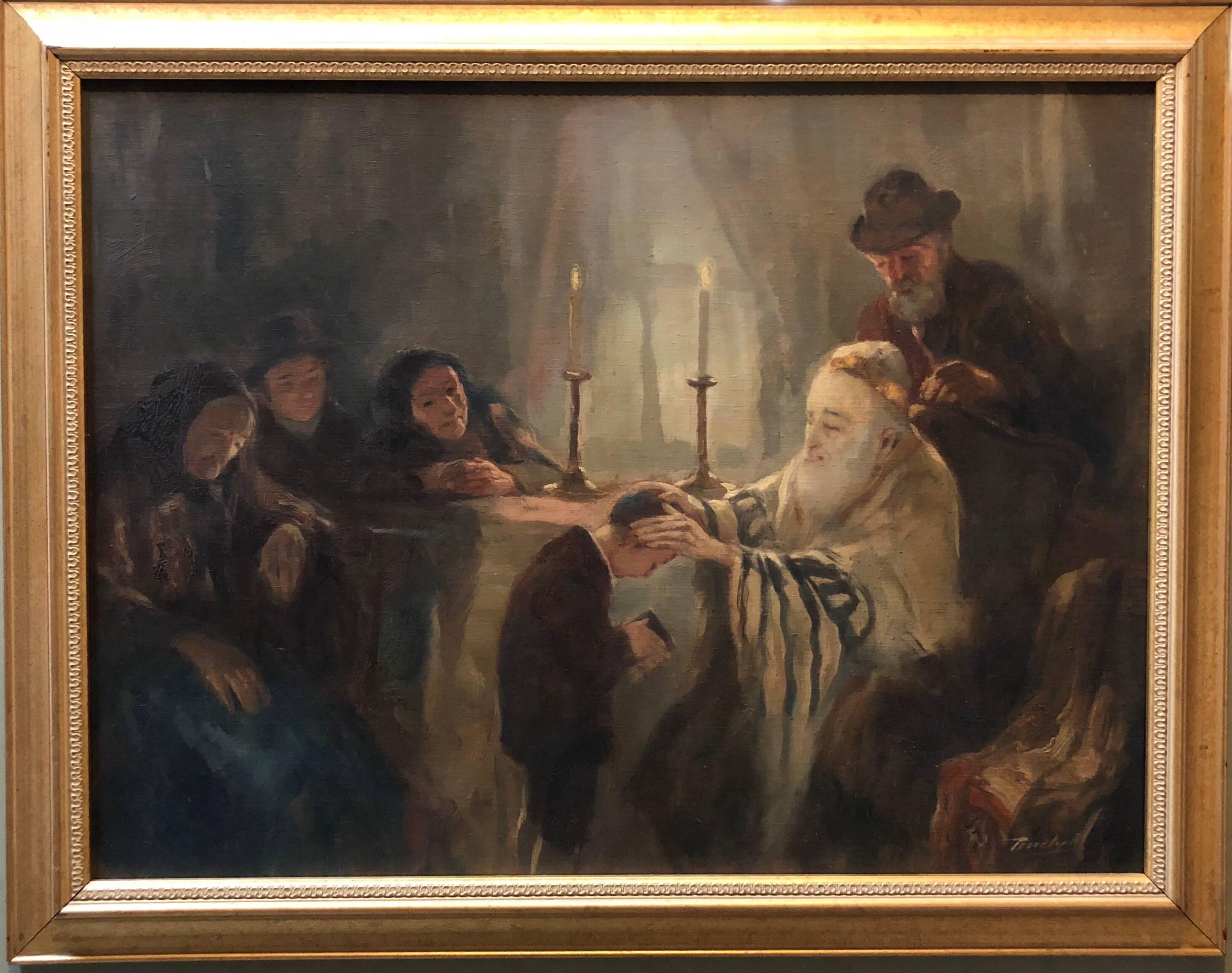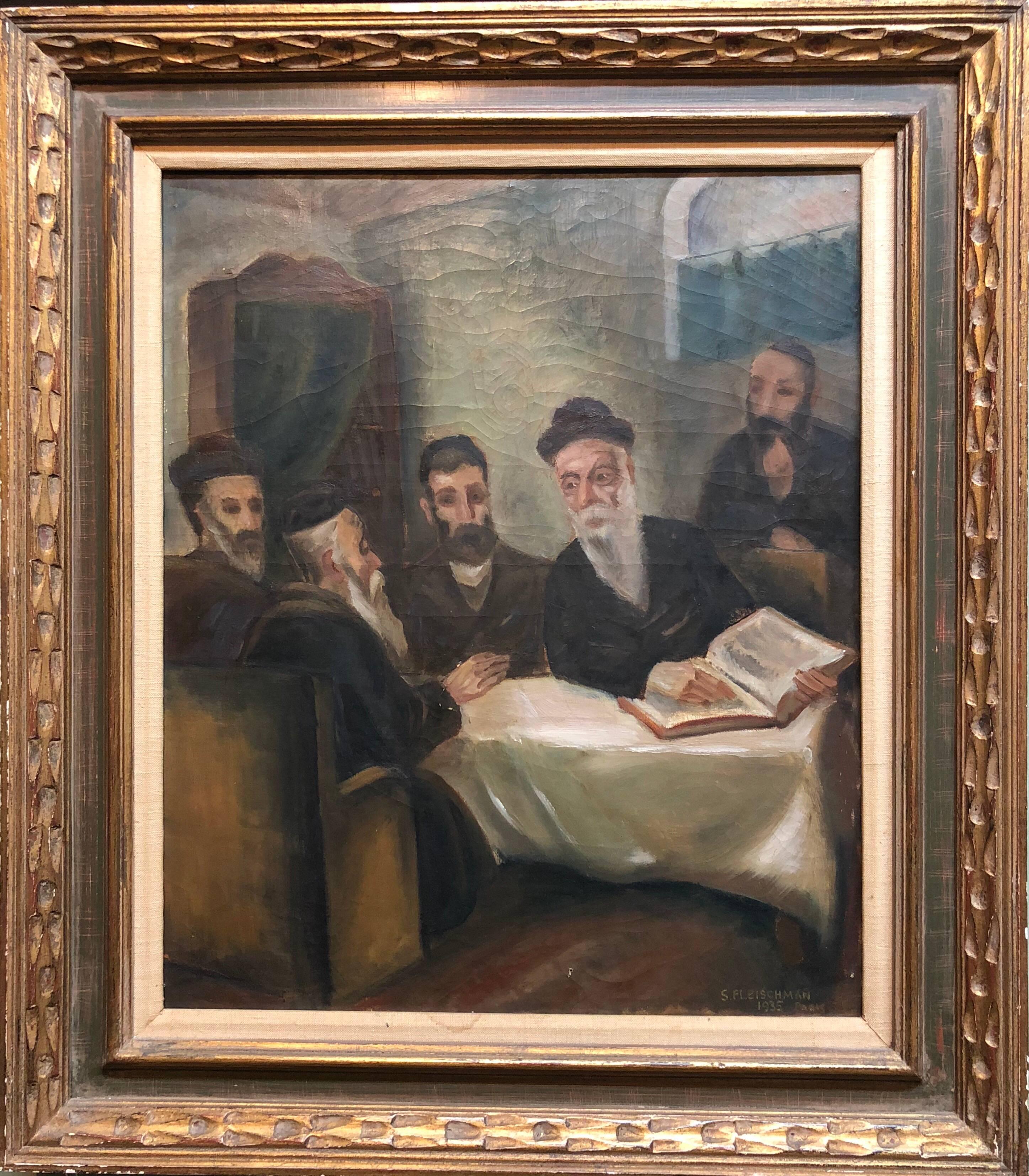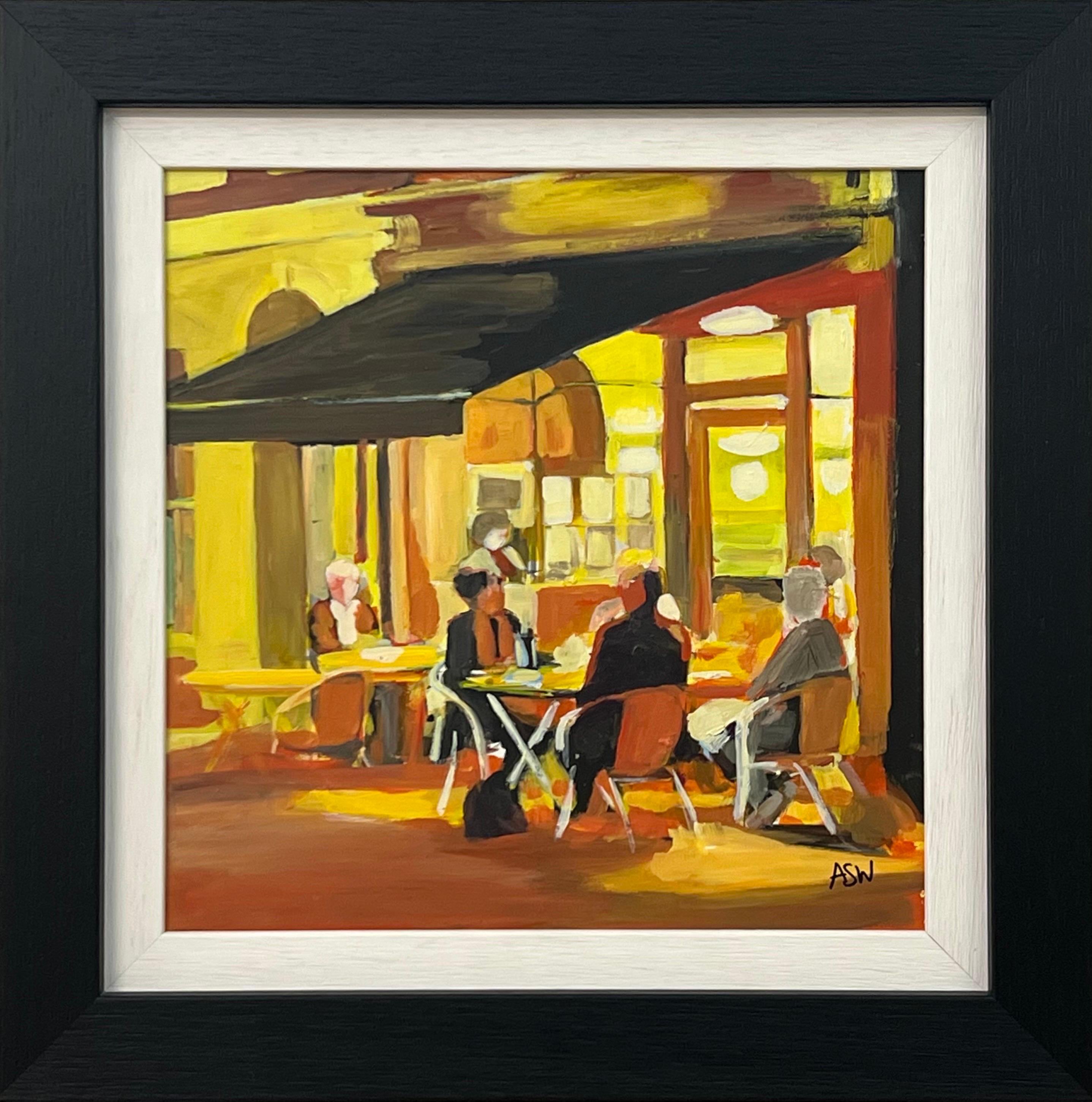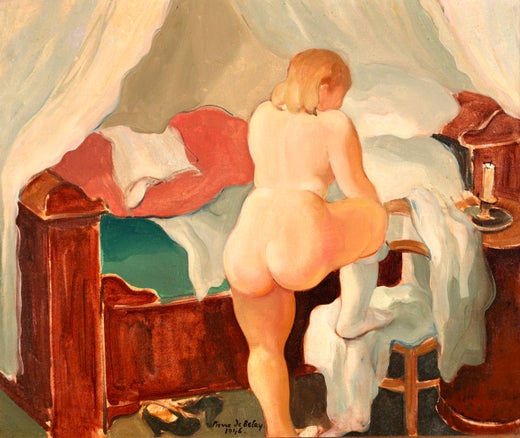Items Similar to Chez Maxim's - Post Impressionist Oil Figures in Interior by Pierre de Belay
Want more images or videos?
Request additional images or videos from the seller
1 of 17
Pierre de BelayChez Maxim's - Post Impressionist Oil Figures in Interior by Pierre de Belay1932
1932
About the Item
Signed and dated figures in interior oil on canvas by French post impressionist painter Pierre De Belay. The work depicts a gentleman in a black morning suit with two elegantly dressed woman, all of whom are enjoying champagne in famous Cafe Maxim's in Paris France.
Signature:
Signed and dated 1932 lower right
Dimensions:
Framed: 23"x26"
Unframed: 15"x18"
Provenance:
Private French collection
Attracted by drawing and painting from his earliest childhood, Pierre de Belay stayed several times in Paris among the painters and poets of Montmartre, which took the place of formal training. He met many famous personalities of the day and painted portraits of many of them, including Max Jacob, James Ensor, Guillaume Apollinaire, James Joyce and Colette. Equally, the portraits of Mickiewicz and Verlaine are worth mentioning.
His work can be divided into two periods, which sometimes overlap. In his adolescent works, he used transition and chiaroscuro in the Romantic tradition. Then a series of Breton landscapes shows him developing in the direction of a more materialist construction. Next came circus scenes and scenes of Parisian life in the 1930s. It was only in 1923 that he met with success, thanks to his decoration of the dining room of the Hotel Ker Moor in Bénodet, which was followed, in 1925 and 1926, by his first solo exhibitions.
After 1935, he produced a large number of works, paintings and drawings devoted to judges and lawyers, which show an expressionist technique that would culminate in figures such as The Drinker of 1936 or the The Bagpiper of 1938. At this stage, de Belay was similar to Soutine in his caricatures of lawyers, dramatic court scenes and scenes of Parisian life. Around 1937, however, his manner underwent a radical change, probably influenced by the engraving he had been doing since 1926, which led him to invent a strange and original way of painting in oils with interlacing brush strokes, which he called 'treillisme'.
Between 1927 and 1928, he exhibited at the Salon d'Automne, between 1926 and 1945 at the Salon des Indépendants, and between 1927 and 1935 at the Salon des Tuileries. He also exhibited in solo shows in Paris from 1926, in Nantes in 1928, Chartres in 1931 and Stockholm in 1939.
After his death, retrospectives were mounted in 1948 and 1951 in Paris, in 1954 in Quimper and in 1955 in Brest. In 2001, he was represented in the exhibition devoted to The Golden Age of Painting in Brittany at the Musée de Vannes, La Cohue.
Museum and Gallery Holdings:
Quimper (MBA): Two Women in a Café (1937)
- Creator:Pierre de Belay (1890 - 1947)
- Creation Year:1932
- Dimensions:Height: 23 in (58.42 cm)Width: 26 in (66.04 cm)
- Medium:
- Movement & Style:
- Period:
- Condition:Very good original condition.
- Gallery Location:Marlow, GB
- Reference Number:
Pierre de Belay
Attracted by drawing and painting from his earliest childhood, Pierre de Belay stayed several times in Paris among the painters and poets of Montmartre, which took the place of formal training. He met many famous personalities of the day and painted portraits of many of them, including Max Jacob, James Ensor, Guillaume Apollinaire, James Joyce and Colette. Equally, the portraits of Mickiewicz and Verlaine are worth mentioning. His work can be divided into two periods, which sometimes overlap. In his adolescent works, he used transition and chiaroscuro in the Romantic tradition. Then a series of Breton landscapes shows him developing in the direction of a more materialist construction. Next came circus scenes and scenes of Parisian life in the 1930s. It was only in 1923 that he met with success, thanks to his decoration of the dining room of the Hotel Ker Moor in Bénodet, which was followed, in 1925 and 1926, by his first solo exhibitions. After 1935, he produced a large number of works, paintings and drawings devoted to judges and lawyers, which show an expressionist technique that would culminate in figures such as The Drinker of 1936 or the The Bagpiper of 1938. At this stage, de Belay was similar to Soutine in his caricatures of lawyers, dramatic court scenes and scenes of Parisian life. Around 1937, however, his manner underwent a radical change, probably influenced by the engraving he had been doing since 1926, which led him to invent a strange and original way of painting in oils with interlacing brush strokes, which he called ‘treillisme’. Between 1927 and 1928, he exhibited at the Salon d’Automne, between 1926 and 1945 at the Salon des Indépendants, and between 1927 and 1935 at the Salon des Tuileries. He also exhibited in solo shows in Paris from 1926, in Nantes in 1928, Chartres in 1931 and Stockholm in 1939. After his death, retrospectives were mounted in 1948 and 1951 in Paris, in 1954 in Quimper and in 1955 in Brest. In 2001, he was represented in the exhibition devoted to The Golden Age of Painting in Brittany at the Musée de Vannes, La Cohue. Museum and Gallery Holdings Quimper (MBA): Two Women in a Café (1937)
About the Seller
5.0
Platinum Seller
These expertly vetted sellers are 1stDibs' most experienced sellers and are rated highest by our customers.
Established in 2001
1stDibs seller since 2016
673 sales on 1stDibs
Typical response time: 2 hours
- ShippingRetrieving quote...Ships From: Marlow, United Kingdom
- Return PolicyA return for this item may be initiated within 3 days of delivery.
More From This SellerView All
- Le Piano - Post Impressionist Figurative Interior Painting by Emilio Grau SalaBy Emilio Grau SalaLocated in Marlow, BuckinghamshireSigned and titled oil on canvas figure in interior circa 1950 by Spanish post impressionist Emilio Grau Sala. The work depicts a red-haired lady in a red dress seated at a piano. A y...Category
1950s Post-Impressionist Figurative Paintings
MaterialsCanvas, Oil
- Maternite - Post Impressionist Figurative Interior Oil Painting - Henri LebasqueBy Henri LebasqueLocated in Marlow, BuckinghamshireSigned figurative oil on canvas circa 1910 by French post impressionist painter Henri Lebasque. The work depicts a mother seated on a yellow change feeding her young baby. Signature...Category
1910s Post-Impressionist Figurative Paintings
MaterialsCanvas, Oil
- Le Cafe de la Place Blanche - Post Impressionist Oil, Figures by Elie PavilBy Elie Anatole PavilLocated in Marlow, BuckinghamshireSigned figures in interior oil on panel circa 1915 by Russian-born post impressionist painter Elie Anatole Pavil. The piece depicts a couple in the famous "White Cross" cafe at the P...Category
1910s Post-Impressionist Figurative Paintings
MaterialsOil, Panel
- Dimanche - Post Impressionist Figurative Interior Oil Painting Paul Elie GernezBy Paul-Élie GernezLocated in Marlow, BuckinghamshirePost impressionist signed and dated oil on paper laid on panel by French painter Paul Elie Gernez. The work depicts a woman wearing a black dress with...Category
1920s Post-Impressionist Figurative Paintings
MaterialsPaper, Laid Paper, Panel, Oil
- Old Men with Kittens - Impressionist Oil, Figures in Interior by J F RaffaelliBy Jean-Francois RaffaelliLocated in Marlow, BuckinghamshireA wonderful oil on panel by French impressionist painter Jean-Francois Raffaelli depicting two old men seated in an interior. One is reading his paper as the other naps and there are several kittens on the floor. Painted in the artist's distinctive style. The work is accompanied by a certificate from Brame & Lorenceau and is included in the catalogue raisonne of the painter. Signature: Signed lower left Dimensions: Framed: 9.5"x8" Unframed: 5.5"x4" Provenance: Private collection - United States Original artists label verso Jean-François Raffaëlli's father was a failed Italian businessman and Raffaëlli himself was, among other things, a church chorister, actor and theatre singer. He then studied under Gérôme at the École des Beaux-Arts in Paris. He travelled to Italy, Spain and Algeria and on his return to France settled in Asnières. In 1876, on a trip to Brittany, he first saw the potential of realist subject matter, if treated seriously. He became involved in meetings of artists at the Café Guerbois, where the Impressionist painters used to gather. As a result, Degas, contrary to the advice of the group, introduced Raffaëlli to the Impressionist exhibitions - according to one uncertain source as early as the very first exhibition, at the home of Nadar, and certainly to those of 1880 and 1881. In 1904, Raffaëlli founded the Society for Original Colour Engraving. He first exhibited at the Salon de Paris in 1870 and continued to exhibit there until he joined the Salon des Artistes Français in 1881, where he earned a commendation in 1885, was made Chevalier of the Légion d'Honneur in 1889 and in the same year was awarded a gold medal at the Exposition Universelle. In 1906 he was made Officier of the Légion d'Honneur. He was also a member of the Société Nationale des Beaux-Arts. In 1884, a private exhibition of his work cemented his reputation. He contributed to several newspapers such as The Black Cat (Le Chat Noir) in 1885 and The French Mail (Le Courrier Français) in 1886 and 1887. He published a collection entitled Parisian Characters, which captured his favourite themes of the street, the neighbourhood and local people going about their lives. In 1880 he participated, with Forain, on the illustration of Joris Karl Huysmans' Parisian Sketches (Croquis Parisiens). He also illustrated Huysman's Works. As well as working as an illustrator, he also made etchings and coloured dry-points. His early attempts at painting were genre scenes, but once he was settled in Asnières he started to paint picturesque views of Parisian suburbs. From 1879 onwards, his subject matter drew on the lives of local people. These popular themes, which he treated with humanity and a social conscience, brought him to the attention of the social realist writers of the time such as Émile Zola. In addition to his realist style, Raffaëlli's dark palette, which ran contrary to the Impressionist aesthethic, helped to explain the opposition of those painters to his participation in their exhibitions. More concerned with drawing than colour, he used black and white for most of his paintings. Towards the end of his life, he lightened his palette, but without adopting any other principles of the Impressionist technique. After painting several portraits, including Edmond de Goncourt and Georges Clémenceau, he returned to genre painting, particularly scenes of bourgeois life. Later in his career, he painted mainly Breton-inspired sailors and views of Venice. His views of the Paris slums and the fortifications, sites which have almost completely disappeared, went some way towards establishing a genre in themselves and perpetuated the memory of the area: The Slums, Rag-and-Bone Man, Vagabond, Sandpit, In St-Denis, Area of Fortifications. His realistic and witty portrayal of typical Parisian townscapes accounts for his enduring appeal. Born in Paris, he was of Tuscan descent through his paternal grandparents. He showed an interest in music and theatre before becoming a painter in 1870. One of his landscape paintings was accepted for exhibition at the Salon in that same year. In October 1871 he began three months of study under Jean-Léon Gérôme at the École des Beaux-Arts in Paris; he had no other formal training. Raffaëlli produced primarily costume pictures until 1876, when he began to depict the people of his time—particularly peasants, workers, and ragpickers seen in the suburbs of Paris—in a realistic style. His new work was championed by influential critics such as J.-K. Huysmans, as well as by Edgar Degas. The ragpicker became for Raffaëlli a symbol of the alienation of the individual in modern society. Art historian Barbara S. Fields has written of Raffaëlli's interest in the positivist philosophy of Hippolyte-Adolphe Taine, which led him to articulate a theory of realism that he christened caractérisme. He hoped to set himself apart from those unthinking, so-called realist artists whose art provided the viewer with only a literal depiction of nature. His careful observation of man in his milieu paralleled the anti-aesthetic, anti-romantic approach of the literary Naturalists, such as Zola and Huysmans. Degas invited Raffaëlli to participate in the Impressionist exhibitions of 1880 and 1881, an action that bitterly divided the group; not only was Raffaëlli not an Impressionist, but he threatened to dominate the 1880 exhibition with his outsized display of 37 works. Monet, resentful of Degas's insistence on expanding the Impressionist exhibitions by including several realists, chose not to exhibit, complaining, "The little chapel has become a commonplace school which opens its doors to the first dauber to come along."An example of Raffaëlli's work from this period is Les buveurs d'absinthe (1881, in the California Palace of Legion of Honor Art Museum in San Francisco). Originally titled Les déclassés, the painting was widely praised at the 1881 exhibit. After winning the Légion d'honneur in 1889, Raffaëlli shifted his attention from the suburbs of Paris to city itself, and the street scenes that resulted were well received by the public and the critics. He made a number of sculptures, but these are known today only through photographs.[2] His work was also part of the painting event in the art competition at the 1912 Summer Olympics. In the later years of his life, he concentrated on color printmaking. Raffaëlli died in Paris on February 11, 1924 Museum and Gallery Holdings: Béziers: Peasants Going to Town Bordeaux: Bohemians at a Café Boston: Notre-Dame; Return from the Market Brussels: Chevet of Notre-Dame; pastel Bucharest (Muz. National de Arta al României): Market at Antibes; Pied-à-terre Copenhagen: Fishermen on the Beach Douai: Return from the Market; Blacksmiths Liège: Absinthe Drinker...Category
1890s Impressionist Figurative Paintings
MaterialsPanel, Oil
- A Breton Interior - Impressionist Interior Oil Painting by Edouard CortesBy Édouard Leon CortèsLocated in Marlow, BuckinghamshireSigned figures in interior oil on canvas circa 1910 by sought after French impressionist painter Edouard Leon Cortes. This charming and nostalgic work depicts a family enjoying dinne...Category
Early 20th Century Impressionist Interior Paintings
MaterialsCanvas, Oil
You May Also Like
- Blessing of the Tzadik (Rebbe) Rare Hungarian Judaica Oil PaintingBy Anton PeczelyLocated in Surfside, FLRare Pre World War II (Pre Holocaust) Judaica Art. European Judaic art from this period is exceedingly rare. Péczely Antal Anton 1891 - 1963 Known for his Jewish genre scenes, Chess scenes and other early 20th Century salon style paintings. In the tradition of Moritz Oppenheim...Category
Early 20th Century Post-Impressionist Figurative Paintings
MaterialsOil, Board
- "Laundry" Post-Impressionism French Oil Painting Interior Scene Figure on BoardBy Jacques ZuckerLocated in New York, NYThis painting depicts a whimsical portrait of a young lady washing her laundry in front of a house. This piece was most likely executed in the 1930's, as the colors are darker than Z...Category
1960s Post-Impressionist Figurative Paintings
MaterialsOil, Board
- Wisdom of King Solomon Rare Biblical Hungarian Judaica Oil PaintingBy Anton PeczelyLocated in Surfside, FLRare Pre World War II (Pre Holocaust) Judaica Art. European Judaic art from this period is exceedingly rare. Péczely Antal Anton 1891 - 1963 Known for his Jewish genre scenes, Chess scenes and other early 20th Century salon style paintings. In the tradition of Moritz Oppenheim...Category
Early 20th Century Post-Impressionist Figurative Paintings
MaterialsOil, Board
- Rare French, Paris 1935 Judaica Oil Painting Rabbis Studying S. FleischmanLocated in Surfside, FLRare Judaica Art. Jewish genre scene. In the tradition of Moritz Oppenheim, Isidor Kauffman and Maurycy Gottlieb and later of Tully Filmus, Zalman Kleinman and Itshak Holtz the artist captures this Jewish scene with a particular sensitivity. Part of the Ecole De Paris The term "School of Paris" was used in 1925 by André Warnod (fr) to refer to the many foreign-born artists who had migrated to Paris. School of Paris artists were progressively marginalized. Beginning in 1935 art publications no longer wrote about Marc Chagall, just magazines for Jewish audiences, and by June 1940 when the Vichy government took power, School of Paris artists could no longer exhibit in Paris at all. The artists working in Paris between World War I and World War II experimented with various styles including Cubism, Orphism, Surrealism and Dada. Foreign and French artists working in Paris included Jean Arp, Joan Miró, Constantin Brâncuși, Raoul Dufy, Tsuguharu Foujita, artists from Belarus like Michel Kikoine, Pinchus Kremegne, and Jacques Lipchitz, the Polish artist Marek Szwarc and others such as Russian-born prince Alexis Arapoff. A significant subset, the Jewish artists, came to be known as the Jewish School of Paris or the School of Montparnasse. The "core members were almost all Jews, and the resentment expressed toward them by French critics in the 1930s was unquestionably fueled by anti-Semitism." One account points to the 1924 Salon des Indépendants, which decided to separate the works of French-born artists from those by immigrants; in response critic Roger Allard (fr) referred to them as the School of Paris. Jewish members of the group included Emmanuel Mané-Katz, Chaim Soutine, Adolphe Féder, Chagall, Moïse Kisling, Maxa Nordau...Category
Mid-20th Century Post-Impressionist Figurative Paintings
MaterialsOil, Board
- Woman from behind oil paintingBy Rafael Duran BenetLocated in Barcelona, BarcelonaRafael Duran Benet (1931-2015) - Woman from behind - Oil on canvas cardnoard Oil measurements 55x46 cm. Frameless. Rafael Duran Benet (Terrassa, 1931 - Barcelona, 2015) is a Catalan...Category
1990s Post-Impressionist Figurative Paintings
MaterialsOil, Cardboard, Canvas
- Painting Study of Al Fresco Spanish Tapas Bar Scene at Night by British ArtistBy Angela WakefieldLocated in Preston, GBPainting Study of Al Fresco Spanish Tapas Bar Scene at Night by leading British Landscape Artist, Angela Wakefield. Art measures 12 x 12 inches Frame me...Category
2010s Post-Impressionist Interior Paintings
MaterialsGesso, Fiberboard, Board, Acrylic, Oil, Mixed Media, Varnish, Paint
Recently Viewed
View AllMore Ways To Browse
Signed Pierre Paintings
Hotel De Paris
Pierre Oil Painting
Pierre Oil
Pierre Signed Oil Painting
Oil On Canvas By Pierre
Pierre Hotel
French Post Expressionist
Oil Painting Dining Room
Breton Oil
Guillaume Apollinaire
Figures In A Cafe
Vintage Lawyer
Paris Cafe Scenes
Impressionist Cafe Scene
French Court Scene Paintings
Engraving Board
Circus Figures





